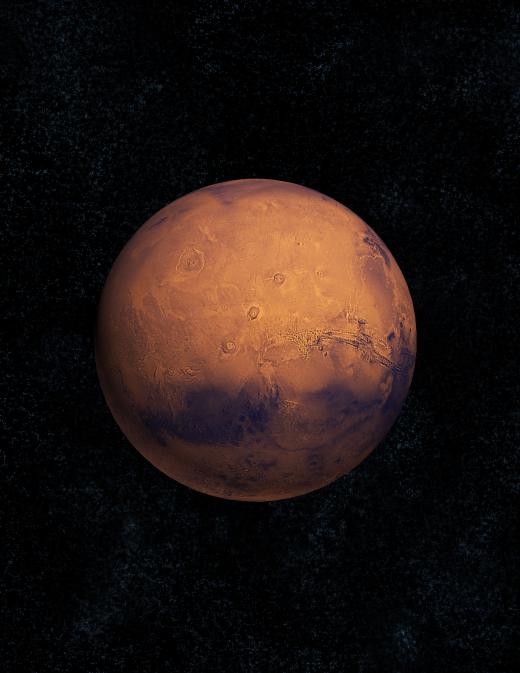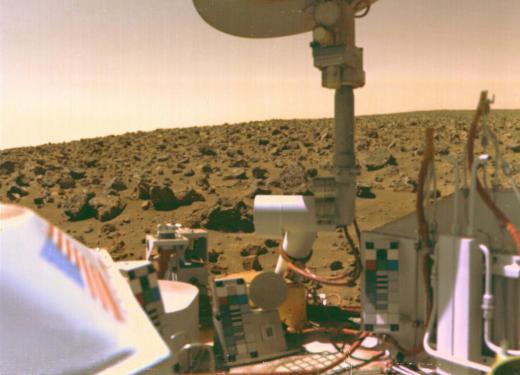What are Some Schemes for Terraforming Mars?
 Michael Anissimov
Michael Anissimov
In the long run, many people believe that mankind will need more room. Although it is likely that the Earth could hold many more billions of people without crowding — as long as the productivity of farming is increased and a transition to renewable energy is made — eventually people may need to live off planet. The most obvious target for such colonization is Mars, which is located only 60% farther away from the Sun than the Earth is, and is the only inner planet besides Earth that has a mild temperature and pressure. Mars' surface area is about 29% that of the Earth's, an area comparable to that of all the continents combined, including Antarctica. Some basic schemes for terraforming Mars involve raising the temperature and the atmospheric pressure on the planet, and finding ways to release water and oxygen.
The hypothetical process of making another planet more Earth-like has been called terraforming, and terraforming Mars is a frequently mentioned possibility in terraforming discussions. To make Mars habitable to humans and earthly life, three major modifications are necessary. First, the pressure of the atmosphere must be increased, as the pressure on the surface of Mars is only about 1/100th that of the Earth. The atmosphere would also need the addition of oxygen. Second, the atmosphere must be kept warm. A warm atmosphere would melt the large quantities of water ice on Mars, solving the third problem, the absence of water.

Terraforming Mars by building up its atmosphere could be initiated by raising the temperature, which would cause the planet's vast CO2 ice reserves to sublime and become atmospheric gas. The current average temperature on Mars is -51°F (−46°C), with lows of -125°F (−87°C), meaning that all water and much carbon dioxide is permanently frozen. The easiest way to raise the temperature seems to be by introducing large quantities of CFCs — chlorofluorocarbons, a highly effective greenhouse gas — into the atmosphere, which could be done by sending rockets filled with compressed CFCs on a collision course with Mars.

After impact, the CFCs would drift throughout Mars' atmosphere, causing a greenhouse effect which would raise the temperature, leading CO2 to sublimate and further continuing the warming and atmospheric buildup. The sublimation of gas would generate massive winds, which would kick up large quantities of dust particles, which would further heat the planet through direct absorption of the Sun's rays. After a few years, the largest dust storms would subside, and the planet could become habitable to certain types of algae and bacteria, which would serve as the forerunners of all other life. In an environment without competitors and abundant in CO2, they would thrive. This would be the biggest step in terraforming Mars.

Over time, the algae and bacteria would spread across the planet, turning the ground green, which would reduce the albedo or reflectiveness of Mars, thereby absorbing even more heat. Eventually, the temperature in many areas would exceed that of the freezing point of water, and the atmospheric pressure would increase due to all the released gasses, crossing that magical line where the formation of liquid water becomes possible. At this point, humans on the planet would need little more than an oxygen tank to survive in the open. In the longer run, large quantities of oxygen could be released by processing oxide metals found on the surface. Terraforming Mars could take decades or even centuries, but many feel that the new space it gave us would be worth it.
AS FEATURED ON:
AS FEATURED ON:
















Discussion Comments
Here are ten reasons terraforming Mars is a bad idea: No magnetic field to shield from radiation and sputtering of the atmosphere. No plate tectonics to recycle carbon and water and rebuild eroded land. No large moon to stabilize the axial tilt and provide tides. Much more elliptical orbit, which means much more erratic climate. Much higher rate of impacts due to proximity of Jupiter and the asteroid belt. Gravity only .38 that of Earth. No mountain chains to break up atmospheric currents and release precipitation. Surface covered in toxic perchlorates. Asymmetry between hemispheres means all land on one side and all ocean on the other. This would make the interior of the landmass extremely dry and would prevent ocean circulation from transferring heat and oxygenating the water. No plausible economic rationale to justify the vast amounts of time and money necessary. (Sorry, a bunch of nerds thinking it would be really cool doesn't cut it.)
Suggesting that we must terraform mars because we are ovverruning this world is like asking Dracula to turn the Mummy into a human being just so he can suck his blood out.
Absolutely we need to get this started immediately! I bet some guy at NASA snuck in some kind of microbes already aboard one or another probe or explorer.
um, not to go against you or anything anon, you do make some good arguments. But what you are saying makes it sound like terraforming mars is a bad idea. yes, we have been less than kind to the planet we have, but that is human nature. we desire control and will go to drastic measures to achieve control. but that is not the point. at the rate our population is growing we will definitely run out of room sometime, and we will need somewhere to go. unless we find a way to wake someone who has been in cryo sleep, and send significant amounts of people out to the new planet 20,000 light years away. mars is the closest solution.
We could terraform Mars and send all the environmentalists there to do as they pleased with it. I know they'd rather have it the other way around and leave earth to them but I think they could really have fun on Mars and we could have fun without them.
Let all the planet earth's scientcists get together and give us a more habitable world instead of working on unfeasible terraforming activities.
Just wondering, who will have authority over who can and who cannot go to Mars?
What would be done to mitigate the much higher probability of asteroid impacts on Mars? After all, the orbit of Mars is right on the edge of the asteroid belt.
Hubris is woven throughout this article. While I realize it is speaking to the human ability to make Mars a habitat which would support life as we know it, the changing of a planet to meet our own needs is questionable. We haven't done such a good job on the planet we already have.
Post your comments